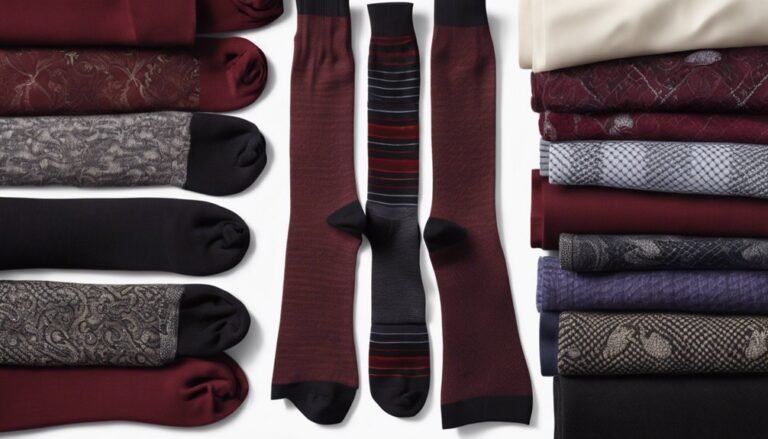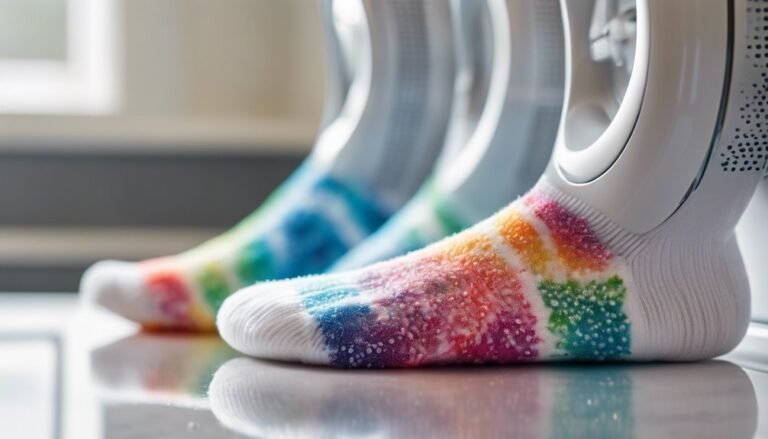Yoga Socks vs. Pilates Socks: Which Helps With Stability More?
When it comes to stability, both yoga and Pilates socks have their strengths. Yoga socks typically feature advanced grip technology that prevents slipping, helping you stay centered during poses. In contrast, Pilates socks often incorporate arch support and varied traction patterns to maintain grip on reformers and mats. Your choice will depend on your practice style and personal preference. If you're curious about the unique advantages each sock offers, there's plenty more to discover!
Understanding Yoga Socks: Features and Benefits

Yoga socks are an essential accessory for anyone looking to enhance their practice, providing both comfort and stability on your mat. With various yoga sock styles available, you'll find options that cater to your needs, whether you prefer full coverage or toe-less designs. These socks often feature grip patterns on the soles, ensuring you maintain a solid footing during challenging poses. Additionally, moisture management is vital; many socks are crafted from breathable materials that wick away sweat, keeping your feet dry and comfortable. This not only enhances your performance but also prevents slipping, allowing you to focus entirely on your practice. Ultimately, investing in quality yoga socks can transform your experience, helping you achieve greater freedom and confidence on your mat.
Exploring Pilates Socks: Key Characteristics
While yoga socks enhance stability and comfort on the mat, Pilates socks bring their own unique benefits to the practice. Designed specifically for Pilates, these socks incorporate various design elements to elevate your experience. Here are some key characteristics:
- Grip-enhancing soles: Help maintain traction during movements.
- Arch support: Provides additional stability and comfort.
- Breathable materials: Keep your feet cool throughout your session.
- Open-toe design: Allows for better sensory feedback and freedom of movement.
User feedback often highlights how these socks improve overall performance and confidence during Pilates exercises. By opting for the right pair, you can experience enhanced control and fluidity, ultimately freeing your practice from limitations.
Grip and Traction: Comparing the Two Styles
When it comes to grip and traction, the differences between yoga socks and Pilates socks can markedly impact your practice. Yoga socks typically feature advanced grip technology, designed to enhance stability on a mat. The rubberized dots or patterns on the soles provide a firm hold, allowing you to focus on your poses without slipping. In contrast, Pilates socks may utilize varied traction patterns that cater to movements on reformers or mats. While some have a more minimalistic design, their grip can still be effective for maintaining balance during dynamic exercises. Ultimately, your choice between the two should depend on your preferred practice style, as each sock type offers unique advantages in grip and traction, influencing how freely you can move.
Cushioning and Support: Which Is More Beneficial?

Choosing the right socks can greatly influence your comfort and performance during practice, especially regarding cushioning and support. Consider these factors when selecting your socks:
- Cushion types: Extra padding can absorb impact and reduce fatigue.
- Support levels: Arch support helps maintain foot alignment and comfort.
- Fit and flexibility: A snug fit allows for movement without restriction.
- Activity-specific designs: Tailored features enhance stability for yoga or Pilates.
In yoga, minimal cushioning promotes a strong connection to the mat, while Pilates socks often provide more padding for support during dynamic movements. Ultimately, it's about finding the right balance of cushion types and support levels that resonate with your practice style, allowing you to move freely and confidently.
Material Matters: Fabric Differences in Stability
Understanding the material of your socks can greatly impact your stability during yoga or Pilates practice. Different fabric types serve distinct purposes; for instance, cotton offers comfort but can absorb moisture, leading to slippage. On the other hand, synthetic materials, like nylon and polyester, provide moisture-wicking properties that keep your feet dry and enhance grip. This is essential when you're in challenging poses or shifts. Additionally, some socks feature rubberized dots on the soles for improved traction, which can further bolster stability during your workouts. Ultimately, selecting the right fabric can make a noticeable difference in how grounded you feel, allowing you to focus on your practice rather than worrying about slipping or losing balance.
Personal Preference: Choosing the Right Sock for Your Practice
How do you find the perfect sock for your yoga or Pilates practice? The right sock can enhance your experience, offering both stability and personal comfort. Here are some key factors to take into account:
- Sock styles: Explore different designs, like grip socks, toe socks, or ankle-length options.
- Fit: Verify your socks aren't too tight or loose; they should move with you.
- Material: Look for breathable fabrics that wick moisture away, keeping your feet dry.
- Grip: Assess the level of traction you need based on your practice intensity.
Ultimately, your choice will depend on what feels best for you. Embrace the freedom to experiment with various options until you discover the sock that perfectly aligns with your practice.
Frequently Asked Questions
Can I Use Yoga Socks for Pilates and Vice Versa?
You can definitely use yoga socks for Pilates and vice versa. Just keep in mind that yoga socks' durability may differ from Pilates socks' features, which often provide extra grip tailored for specific movements.
Do Yoga Socks Come in Different Sizes for Better Fit?
Isn't it great when something fits just right? Yoga socks do come in size variations to accommodate your fit preferences, ensuring comfort and support during your practice. Finding the perfect pair can enhance your experience considerably.
Are There Eco-Friendly Options for Yoga and Pilates Socks?
Yes, there're eco-friendly options for your yoga and Pilates socks! Look for those made from sustainable materials or biodegradable options, ensuring your practice is both enjoyable and environmentally conscious. You can make a positive impact!
How Often Should I Replace My Yoga or Pilates Socks?
Imagine you're at a class, and your socks start slipping. To avoid that, replace your yoga or pilates socks every 6-12 months, depending on sock lifespan and material durability, ensuring you maintain ideal grip and comfort.
Can I Wear Yoga or Pilates Socks Outside the Studio?
Absolutely, you can wear yoga or pilates socks outside the studio! Their outdoor versatility and unique designs make for fashionable choices. Just make sure they're comfortable and suitable for your activities to maintain that sense of freedom.







